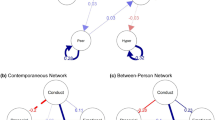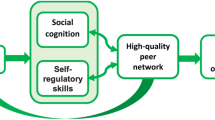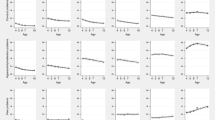Abstract
The study investigated the predictive value of pro-social behaviour for developmental pathways of behavioural and emotional problems at kindergarten age. One hundred and sixty children participated in the study at the ages of 5 and 6. Teachers and parents completed the Strengths and Difficulties Questionnaire; children completed the Berkeley Puppet Interview at both assessment points. Single-informant data were aggregated to enhance the reliability and validity of data. Gender and parental educational status were controlled.
Symptoms (conduct problems, hyperactivity and emotional symptoms) and pro-social behaviour were moderately stable over time. Compared to girls, boys showed higher levels and increases of conduct problems and hyperactivity and lower levels of pro-social behaviour. Lower parental educational level was associated with higher levels and increases in hyperactivity. Although pro-social behaviour was cross-sectionally associated with behavioural and emotional symptoms, pro-social behaviour did not predict changes in conduct problems or hyperactivity over time. However, children with above average emotional symptoms and above average pro-social behaviour at Age_5 showed the highest level of emotional symptoms at Age_6. The results indicate that low levels of pro-social behaviour are associated with children’s externalising behaviour problems, but that for children with high levels of emotional symptoms, higher levels of pro-social behaviour should also be considered as a risk factor.
In sum, our results suggest mainly homotypic pathways of internalising and externalising symptoms across kindergarten age, but indicate that the assessment of pro-social behaviour yields additional information regarding the developmental pathways of emotional symptoms.

Similar content being viewed by others
References
Eisenberg N, Fabes RA (1998) Prosocial development. In: Damon W (ed) Handbook of child psychology. Wiley, New York, pp 701–778
Hay DF (1994) Prosocial development. J Child Psychol Psychiatry 35:29–71
Eron LD, Huesmann LR (1984) The relation of prosocial behavior to the development of aggression and psychopathology. Aggressive Behav 10:201–211
Hastings PD, Zahn-Waxler C, Robinson J, Usher B, Bridges D (2000) The development of concern for others in children with behavioral problems. Dev Psychol 36:531–546
Hay DF, Pawlby S (2003) Prosocial development in relation to children’s and mothers’ psychological problems. Child Dev 74:1314–1327
Hughes C, White A, Sharpen J, Dunn J (2000) Antisocial, angry and unsympathetic: ‘Hard to manage’ preschoolers’ peer problems, and possible cognitive influences. J Child Psychol Psychiatry 41:169–179
Bohlin G, Bengtsgard K, Andersson K (2000) Social inhibition and overfriendliness as related to socioemotional functioning in 7- and 8-year-old children. J Clin Child Psychol 29:414–423
Gjerde P, Block J (1991) Preadolescent antecedents of depressive symptomatology at age 18: a prospective study. J Youth Adolescence 20:217–232
Kraemer H, Measelle JR, Ablow JC, Essex MJ, Boyce WT, Kupfer DJ (2003) A new approach to integrating data from multiple informants in psychiatric assessment and research: mixing and matching contexts and perspectives. Am J Psychiatry 160:1566–1577
Perren S, von Wyl A, Stadelmann S, Bürgin D, von Klitzing K (2006) Associations between kindergarten children’s behavioral/emotional difficulties and the quality of their peer relationships. J Am Acad Child Adoles Psychiatry 45:867–876
Perren S, Von Wyl A, Simoni H, Stadlmayr W, Bürgin D, Von Klitzing K (2003) Parental psychopathology, marital quality, and the transition to parenthood. Am J Orthopsychiatr 73:55–64
Goodman R (1997) The strengths and difficulties questionnaire: a research note. J Child Psychol Psychiatr 38:581–586
Measelle JR, Ablow JC, Cowan PA, Cowan CP (1998) Assessing young children’s views of their academic, social, and emotional lives: an evaluation of the self-perception scales of the Berkeley Puppet Interview. Child Dev 69:1556–1576
Twisk JWR (2003) Applied longitudinal data analysis for epidemiology. A practical guide. University Press, Cambridge
Rutter M (1989) Pathways from childhood to adult life. J Child Psychol Psychiatr 30:23–51
Block JH (1983) Differential premises arising from differential socialization of the sexes: some conjectures. Child Dev 54:1335–1354
Keenan K, Shaw D (1997) Developmental and social influences on young girls’ early problem behavior. Psychol Bull 121:95–113
Scahill L, Schwab Stone M, Merikangas KR, Leckman JF, Zhang H, Kasl S (1999) Psychosocial and clinical correlates of ADHD in a community sample of school-age children. J Am Acad Child Adoles Psychiatry 38:976–984
Kraemer H, Stice E, Kazdin A, Offord DR, Kupfer MD (2001) How do risk factors work together? mediators, moderators, and independent, overlapping, and proxy risk factors. Am J Psychiatry 158:848–856
Zahn-Waxler C, Klimes-Dougan B, Slattery MJ (2000) Internalizing problems of childhood and adolescence: prospects, pitfalls, and progress in understanding the development of anxiety and depression. Dev Psychopathol 12:443–466
Perren S, Alsaker F (2006) Social behavior and peer relationships of victims, bully-victims, and bullies in kindergarten. J Child Psychol Psychiatry 47:45–57
Lyons JS, Uziel-Miller ND, Reyes F, Sokol PT (2001) Strengths of children and adolescents in residential settings: prevalence and associations with psychopathology and discharge placement. J Am Acad Child Adolesc Psychiatry 39:176–181
Masten AS, Curtis WJ (2000) Integrating competence and psychopathology: pathways toward a comprehensive science of adaptation in development. Dev Psychopathol 12:529–550
Author information
Authors and Affiliations
Corresponding author
Additional information
The study was conducted at the Department of Child and Adolescent Psychiatry, University of Basel (Switzerland). The study was supported by the Swiss National Science Foundation (grant 32-66778.01), ‘Freie Akademische Gesellschaft Basel’ and ‘Novartis-Stiftung’.
Rights and permissions
About this article
Cite this article
Perren, S., Stadelmann, S., von Wyl, A. et al. Pathways of behavioural and emotional symptoms in kindergarten children: What is the role of pro-social behaviour?. Eur Child Adolesc Psychiatry 16, 209–214 (2007). https://doi.org/10.1007/s00787-006-0588-6
Accepted:
Published:
Issue Date:
DOI: https://doi.org/10.1007/s00787-006-0588-6




